Halo, Habr! Saya sajikan untuk perhatian Anda terjemahan artikel "Menerapkan RoI Pooling di TensorFlow + Keras" oleh Jaime Sevilla.
Saat ini saya sedang mengambil kursus pembelajaran mesin. Di blok pelatihan "Computer vision" ada kebutuhan untuk mempelajari RoI Pooling of layers. Artikel di bawah ini tampak menarik bagi saya, dan karena itu saya memutuskan untuk membagikan terjemahannya kepada komunitas.
Dalam posting ini, kami akan menjelaskan konsep dasar dan penggunaan umum dari penyatuan RoI ( Region of Interest ) dan memberikan implementasi menggunakan lapisan TensorFlow Keras.
Target audiens dari posting ini adalah orang-orang yang akrab dengan teori dasar (Convolutional) Neural Networks (CNNs) dan mampu membangun dan menjalankan model-model sederhana menggunakan Keras .
Jika Anda hanya di sini untuk kode, periksa di sini dan jangan lupa untuk menyukai dan berbagi artikel!
Memahami RoI Pooling
RoI Pooling diusulkan oleh Ross Girshik dalam artikel Fast R-CNN sebagai bagian dari pipa pengenalan objeknya.
Dalam kasus penggunaan umum untuk RoI Pooling , kami memiliki objek seperti gambar dan beberapa wilayah menarik ( RoI ) yang ditentukan melalui kotak pembatas. Kami ingin membuat embeddings (embeddings - memetakan entitas yang sewenang-wenang (sepotong gambar) ke vektor tertentu) dari setiap RoI.
Misalnya, dalam pengaturan R-CNN, kami memiliki gambar dan mesin penyorot wilayah kandidat yang membuat kotak pembatas untuk bagian gambar yang berpotensi menarik. Sekarang kami ingin membuat embedding untuk setiap bagian gambar yang disarankan.
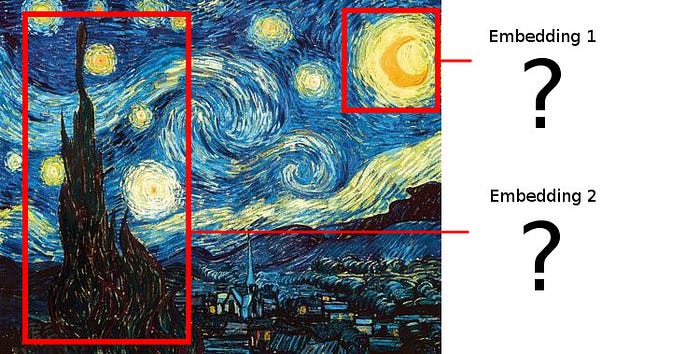
Cukup memotong setiap area yang disarankan tidak akan berfungsi karena kami ingin melapiskan hasil yang dihasilkan di atas satu sama lain, dan area yang disarankan tidak harus memiliki bentuk yang sama!
, . ?
- (pooling).
max pooling, ( ) , , .
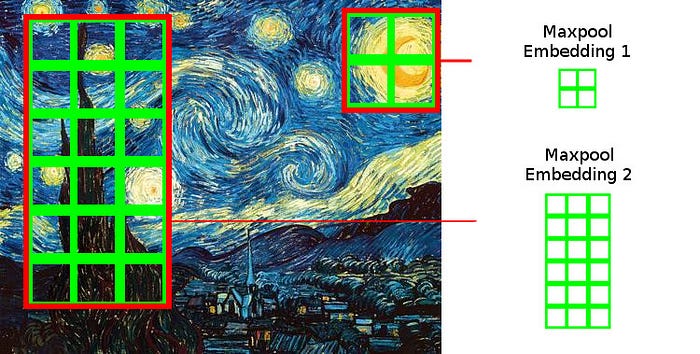
maxpool
, – : .
. RoI ?
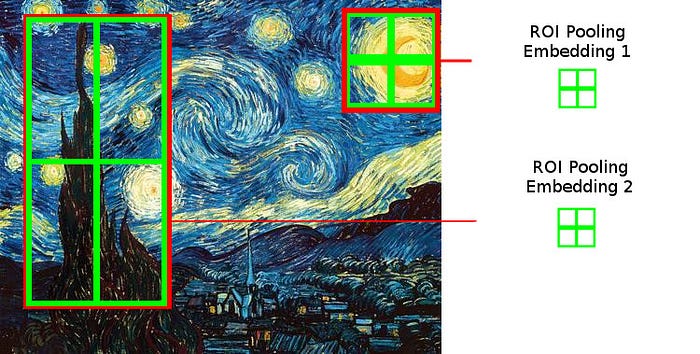
ROI Pooling , pooling.
, ROI Pooling.
RoI Pooling.
RoI Pooling — . , RoI, . , .
-, ( RoI Pooling ), ( ), (end-to-end) (single-pass) .
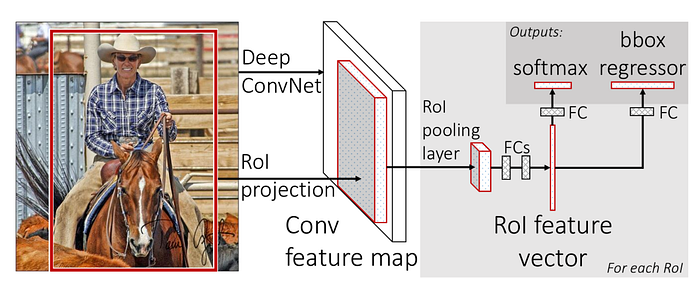
Fast R-CNN, RoI Pooling,
, R-CNN , (RoI). RoI Pooling CNN . .
-, -, RoI Pooling (visual attention).
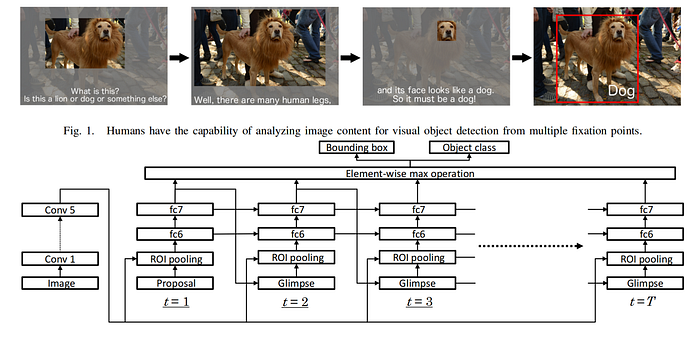
Attentional Network , ROI Pooling, Hara ..
Attentional Network , Hara attention, ROI ROI Pooling. (t = 1), ROI Pooling (Fully Connected). Glimpse () (t = 2) , ROI Pooling. .
.
, , ROI.
:
- (batch) . , . (batch_size, img_width, img_height, n_channels), batch_size- , img_width — , img_height — , n_channels — .
- (batch) ROI. , - . 4 , (batch_size, n_rois, 4), batch_size — ROI, n_rois — ROI.
:
- , ROI. (batch_size, n_rois, pooled_width, pooled_height, n_channels). batch_size- , n_rois — ROI, pooled_width — , pooled_height— , n_channels — .
Keras
Keras Layer.
tf.keras init, build call . , build , , . compute_output_shape.
, .
def __init__(self, pooled_height, pooled_width, **kwargs):
self.pooled_height = pooled_height
self.pooled_width = pooled_width
super(ROIPoolingLayer, self).__init__(**kwargs). , . .
def compute_output_shape(self, input_shape):
""" Returns the shape of the ROI Layer output
"""
feature_map_shape, rois_shape = input_shape
assert feature_map_shape[0] == rois_shape[0]
batch_size = feature_map_shape[0]
n_rois = rois_shape[1]
n_channels = feature_map_shape[3]
return (batch_size, n_rois, self.pooled_height,
self.pooled_width, n_channels)compute_output_shape — , , .
(call). — , . , ROI Pooling, .
, , ROI .
.
@staticmethod
def _pool_roi(feature_map, roi, pooled_height, pooled_width):
""" Applies ROI Pooling to a single image and a single ROI
"""# Compute the region of interest
feature_map_height = int(feature_map.shape[0])
feature_map_width = int(feature_map.shape[1])
h_start = tf.cast(feature_map_height * roi[0], 'int32')
w_start = tf.cast(feature_map_width * roi[1], 'int32')
h_end = tf.cast(feature_map_height * roi[2], 'int32')
w_end = tf.cast(feature_map_width * roi[3], 'int32')
region = feature_map[h_start:h_end, w_start:w_end, :]
..., .
, ROI , 0 1. , ROI 4- , (x_min, y_min, x_max, y_max ).
ROI , , , : , , ROI Pooling, , , ROI.
, TensorFlow.
...
# Divide the region into non overlapping areas
region_height = h_end - h_start
region_width = w_end - w_start
h_step = tf.cast(region_height / pooled_height, 'int32')
w_step = tf.cast(region_width / pooled_width , 'int32')
areas = [[(
i*h_step,
j*w_step,
(i+1)*h_step if i+1 < pooled_height else region_height,
(j+1)*w_step if j+1 < pooled_width else region_width
)
for j in range(pooled_width)]
for i in range(pooled_height)]
...ROI, .
2D , , , .
, , , , ROI (region_height // pooled_height, region_width // pooled_width), ROI, .
2D , .
...
# Take the maximum of each area and stack the result
def pool_area(x):
return tf.math.reduce_max(region[x[0]:x[2],x[1]:x[3],:], axis=[0,1])
pooled_features = tf.stack([[pool_area(x) for x in row] for row in areas])
return pooled_features . pool_area, , , , , .
pool_area , , list comprehension .
(pooled_height, pooled_width, n_channels), RoI .
— RoI . tf.map_fn (n_rois, pooled_height, pooled_width, n_channels).
@staticmethod
def _pool_rois(feature_map, rois, pooled_height, pooled_width):
""" Applies ROI pooling for a single image and varios ROIs
"""
def curried_pool_roi(roi):
return ROIPoolingLayer._pool_roi(feature_map, roi,
pooled_height, pooled_width)
pooled_areas = tf.map_fn(curried_pool_roi, rois, dtype=tf.float32)
return pooled_areas, . tf.map_fn (, x), , .
def call(self, x):
""" Maps the input tensor of the ROI layer to its output
"""
def curried_pool_rois(x):
return ROIPoolingLayer._pool_rois(x[0], x[1],
self.pooled_height,
self.pooled_width)
pooled_areas = tf.map_fn(curried_pool_rois, x, dtype=tf.float32)
return pooled_areas, dtype tf.map_fn , . , , , Tensorflow.
:
import tensorflow as tf
from tensorflow.keras.layers import Layer
class ROIPoolingLayer(Layer):
""" Implements Region Of Interest Max Pooling
for channel-first images and relative bounding box coordinates
# Constructor parameters
pooled_height, pooled_width (int) --
specify height and width of layer outputs
Shape of inputs
[(batch_size, pooled_height, pooled_width, n_channels),
(batch_size, num_rois, 4)]
Shape of output
(batch_size, num_rois, pooled_height, pooled_width, n_channels)
"""
def __init__(self, pooled_height, pooled_width, **kwargs):
self.pooled_height = pooled_height
self.pooled_width = pooled_width
super(ROIPoolingLayer, self).__init__(**kwargs)
def compute_output_shape(self, input_shape):
""" Returns the shape of the ROI Layer output
"""
feature_map_shape, rois_shape = input_shape
assert feature_map_shape[0] == rois_shape[0]
batch_size = feature_map_shape[0]
n_rois = rois_shape[1]
n_channels = feature_map_shape[3]
return (batch_size, n_rois, self.pooled_height,
self.pooled_width, n_channels)
def call(self, x):
""" Maps the input tensor of the ROI layer to its output
# Parameters
x[0] -- Convolutional feature map tensor,
shape (batch_size, pooled_height, pooled_width, n_channels)
x[1] -- Tensor of region of interests from candidate bounding boxes,
shape (batch_size, num_rois, 4)
Each region of interest is defined by four relative
coordinates (x_min, y_min, x_max, y_max) between 0 and 1
# Output
pooled_areas -- Tensor with the pooled region of interest, shape
(batch_size, num_rois, pooled_height, pooled_width, n_channels)
"""
def curried_pool_rois(x):
return ROIPoolingLayer._pool_rois(x[0], x[1],
self.pooled_height,
self.pooled_width)
pooled_areas = tf.map_fn(curried_pool_rois, x, dtype=tf.float32)
return pooled_areas
@staticmethod
def _pool_rois(feature_map, rois, pooled_height, pooled_width):
""" Applies ROI pooling for a single image and varios ROIs
"""
def curried_pool_roi(roi):
return ROIPoolingLayer._pool_roi(feature_map, roi,
pooled_height, pooled_width)
pooled_areas = tf.map_fn(curried_pool_roi, rois, dtype=tf.float32)
return pooled_areas
@staticmethod
def _pool_roi(feature_map, roi, pooled_height, pooled_width):
""" Applies ROI pooling to a single image and a single region of interest
"""
# Compute the region of interest
feature_map_height = int(feature_map.shape[0])
feature_map_width = int(feature_map.shape[1])
h_start = tf.cast(feature_map_height * roi[0], 'int32')
w_start = tf.cast(feature_map_width * roi[1], 'int32')
h_end = tf.cast(feature_map_height * roi[2], 'int32')
w_end = tf.cast(feature_map_width * roi[3], 'int32')
region = feature_map[h_start:h_end, w_start:w_end, :]
# Divide the region into non overlapping areas
region_height = h_end - h_start
region_width = w_end - w_start
h_step = tf.cast( region_height / pooled_height, 'int32')
w_step = tf.cast( region_width / pooled_width , 'int32')
areas = [[(
i*h_step,
j*w_step,
(i+1)*h_step if i+1 < pooled_height else region_height,
(j+1)*w_step if j+1 < pooled_width else region_width
)
for j in range(pooled_width)]
for i in range(pooled_height)]
# take the maximum of each area and stack the result
def pool_area(x):
return tf.math.reduce_max(region[x[0]:x[2], x[1]:x[3], :], axis=[0,1])
pooled_features = tf.stack([[pool_area(x) for x in row] for row in areas])
return pooled_features! , 1- 100x200, 2 RoI, 7x3. , 4 . — 1, 50 (-1, -3).
import numpy as np# Define parameters
batch_size = 1
img_height = 200
img_width = 100
n_channels = 1
n_rois = 2
pooled_height = 3
pooled_width = 7# Create feature map input
feature_maps_shape = (batch_size, img_height, img_width, n_channels)
feature_maps_tf = tf.placeholder(tf.float32, shape=feature_maps_shape)
feature_maps_np = np.ones(feature_maps_tf.shape, dtype='float32')
feature_maps_np[0, img_height-1, img_width-3, 0] = 50
print(f"feature_maps_np.shape = {feature_maps_np.shape}")# Create batch size
roiss_tf = tf.placeholder(tf.float32, shape=(batch_size, n_rois, 4))
roiss_np = np.asarray([[[0.5,0.2,0.7,0.4], [0.0,0.0,1.0,1.0]]], dtype='float32')
print(f"roiss_np.shape = {roiss_np.shape}")# Create layer
roi_layer = ROIPoolingLayer(pooled_height, pooled_width)
pooled_features = roi_layer([feature_maps_tf, roiss_tf])
print(f"output shape of layer call = {pooled_features.shape}")# Run tensorflow session
with tf.Session() as session:
result = session.run(pooled_features,
feed_dict={feature_maps_tf:feature_maps_np,
roiss_tf:roiss_np})
print(f"result.shape = {result.shape}")
print(f"first roi embedding=\n{result[0,0,:,:,0]}")
print(f"second roi embedding=\n{result[0,1,:,:,0]}"), TensorFlow, .
:
feature_maps_np.shape = (1, 200, 100, 1)
roiss_np.shape = (1, 2, 4)
output shape of layer call = (1, 2, 3, 7, 1)
result.shape = (1, 2, 3, 7, 1)
first roi embedding=
[[1. 1. 1. 1. 1. 1. 1.]
[1. 1. 1. 1. 1. 1. 1.]
[1. 1. 1. 1. 1. 1. 1.]]
second roi embedding=
[[ 1. 1. 1. 1. 1. 1. 1.]
[ 1. 1. 1. 1. 1. 1. 1.]
[ 1. 1. 1. 1. 1. 1. 50.]], . — 1, , 50.
, !
, !
, ROI Pooling (attention). , , Keras , ROI Pooling .
, , , !
Ari Brill, Tjark Miener Bryan Kim .
- Ross Girshick. Fast R-CNN. Proceedings of the IEEE International Conference on Computer Vision. 2015.
- Kota Hara, Ming-Yu Liu, Oncel Tuzel, Amir-massoud Farahmand. Attentional Network for Visual Object Detection. 2017.